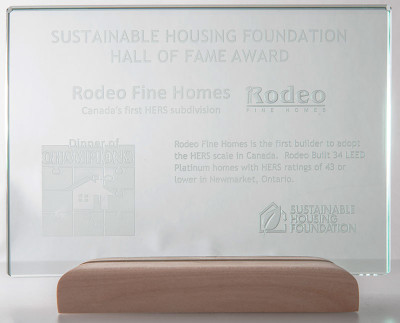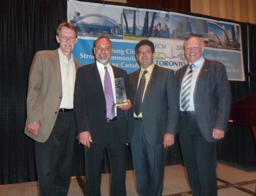By Tracy Hanes
When Rodeo Fine Homes made its first foray into green building, it didn’t do it in small steps. It took a quantum leap. The small custom-home builder took on the task of building Canada’s first LEED Platinum subdivision when it answered a request for proposal from the Town of Newmarket, Ont. In January 2006, Rodeo bought 34 lots for $3.2 million from the town that had been set aside for an environmentally progressive subdivision. The condition was that the homes had to achieve stringent water-use, waste-reduction, and energy-saving goals: 60 percent energy-efficiency savings, 60 per cent less effluent and greenhouse gas emissions, and 25 per cent less water use than code-built houses.
The EcoLogic Subdivision was launched in the summer of 2008, and since then all 34 homes have ben sold. Rodeo managed to achieve its LEED Platinum objective, but not without a steep learning curve and some bumps along the road.
So we had to ask: Is there life after LEED Platinum, and what lessons can be taken from this groundbreaking example of sustainable housing? Here’s what Vince Naccarato of Rodeo Fine Homes has to share about what he and partner Frank Mauro learned from this ambitious exercise in green building.
When Rodeo bought the lots, the company hadn’t as much as constructed a single ENERGY STAR house. “ENERGY STAR was just going and though we enrolled in the program we hadn’t build any ENERGY STAR homes,” explains Naccarato. “These were huge targets but I liked the lots, and we’d built in the area before (Stonehaven, a premier subdivision). Naccarato says in a project basis, “it was challenging, and it was interesting. We also knew that the building code would be changing (in 2012), and we figured we would be first in line to see what we could do.”
After getting feedback from a number of green consultants (including John Gooden and Lenard Hart), Rodeo proposed it would peruse LEED Platinum certification. The project’s architect was Vincent Santamaura of RN Design. “On the marketing front, we needed something the public could relate to, and it fit with what we were doing,” he says. “We weren’t far off from LEED from what we were designing, anyways. We had to tweak the models and do a few other things to get to the LEED Platinum level.”
City staff and council were excited by the idea; far more so than the purchasers, at least initially. “The biggest challenge was demonstrating that we were achieving the energy-efficiency savings,” says Naccarato. “We used a number of consultants, and the town had a peer review consultant check all the numbers. Once we got past that, on the marketing end we had to tell the story, and it was hard to convey the message, because LEED was not even in Canada then. We were involved in the pilot project to bring a version to Canada. “It was so new and with LEED Platinum, people understood that it was the best of the best, but as far as the marketing materials, and all the benefits and features, there was a lot to absorb, and it was difficult to convey. A lot of customers educated themselves before they came in, but there was a lot of material for people to grasp.”
Naccarato says they also had to translate green into dollars, which was difficult. “Some buyers were educated and wanted to buy green and were sold on the concept before they even came in, but no one bought on the spot. Everybody needed to look at what we were doing and had to understand it, that these houses were the highest quality as far as green features.”
The project of single-family, detached executive homes launched in summer of 2008 and opened briskly, but they market crash brought things to a virtual standstill for a year. Eventually all homes sold. They were on 40-, 45- and 60- foot lots, ranged in size from 2,200 sq.ft to 3,600 sq.ft., and prices at about $500,000.
Rodeo had received numerous awards in the past, including an Urban Design Award from the town of Markham; but as a result of this project they gained national recognition with Sustainable Community award from the Federation of Canadian Municipalities (FCM), which was presented to the Town of Newmarket for Rodeo’s EcoLogic site.
Naccarato and Mauro were inundated with green-product suggestions and had to choose ones that would help to achieve the LEED goal. Many came from local suppliers, such as air solar panels, Forest Stewardship Council-certified lumber, and urea formaldehyde-free cabinetry. “Some of the products were easily identified as wastes of time,” says Naccarato. “There were a lot of good products and ones that had been proven out there for awhile, but many had been used only on custom homes.” Most suppliers were from small companies that had been dealing with small one-off projects. “It’s not that 34 houses is a big development but no one else had done 34 at one time,” notes Naccarato. “If a product lent itself to our goals, then we’d use that product. On the mechanical side, it was fairly simple. We used a combination system that had been proven. We used off-the-shelf items that had specs out there on energy saving.”
Naccarato says the biggest bang for the buck was the building envelope itself. Spray foam insulation was used throughout the homes (except for the basements), which provided air sealing, as well as insulation. “It helped with energy savings and it created a type of comfort in the houses,” he explains. “If you have no drafts, you have a very comfortable living environment. The biggest thing really was to concentrate on air tightness and insulation value, and windows. We used low E squared windows with two films instead of one on the inside panes of glass and that helped with passive and reflective solar heat.”
Rodeo used integrated heat recovery ventilators (HRV) and air handlers with a variable speed ECM motor that delivers heating, air conditioning, and ventilation. The air handler, akin to a forced-air furnace without any burners, derives heat from hot water circulated through a fan coil. The HRV transfers 70 per cent of heat from warm exhaust air to fresh incoming cold air, improving indoor air quality and the ECM motor uses 75 per cent less electricity than a conventional furnace fan. Warm-air exhaust from bathrooms and the kitchen, usually vented outside, was directed back through the air handler.
The dual-purpose on-demand boilers (domestic hot wnnater and space heating) lent themselves well to radiant-heat flooring in the basement. “What came standard was the rough-in for radiant-heat flooring, and a lot of people elected to hook it up. The fact that a basement was warm and comfortable went a long way to reduce the amount of time that the clean-air furnace had to work to heat the space,” says Naccarato.
All mechanical system’s ducts were also sealed, as was anywhere there could possibly be air leakage. Under-slab rigid insulation (R10) was used under the basement, “which goes a long way with the heat and is not difficult to install. It’s just getting everybody on board. A key thing was making sure you had trades scheduled for certain times. It involved a lot more co-ordination,” he notes.
Domestic hot water preheats by Enerworks came standard in every house and “that worked well and went a long way to reduce gas consumption. There were some hiccups with it but we got it working well,” notes Naccarato. Naccarato says because the larger EcoLogic homes on 60-foot kits were penalized by LEED, solar-air preheat was implemented (solar panels on the roof were tied into ductwork and warmed air going to clean the air furnace).


